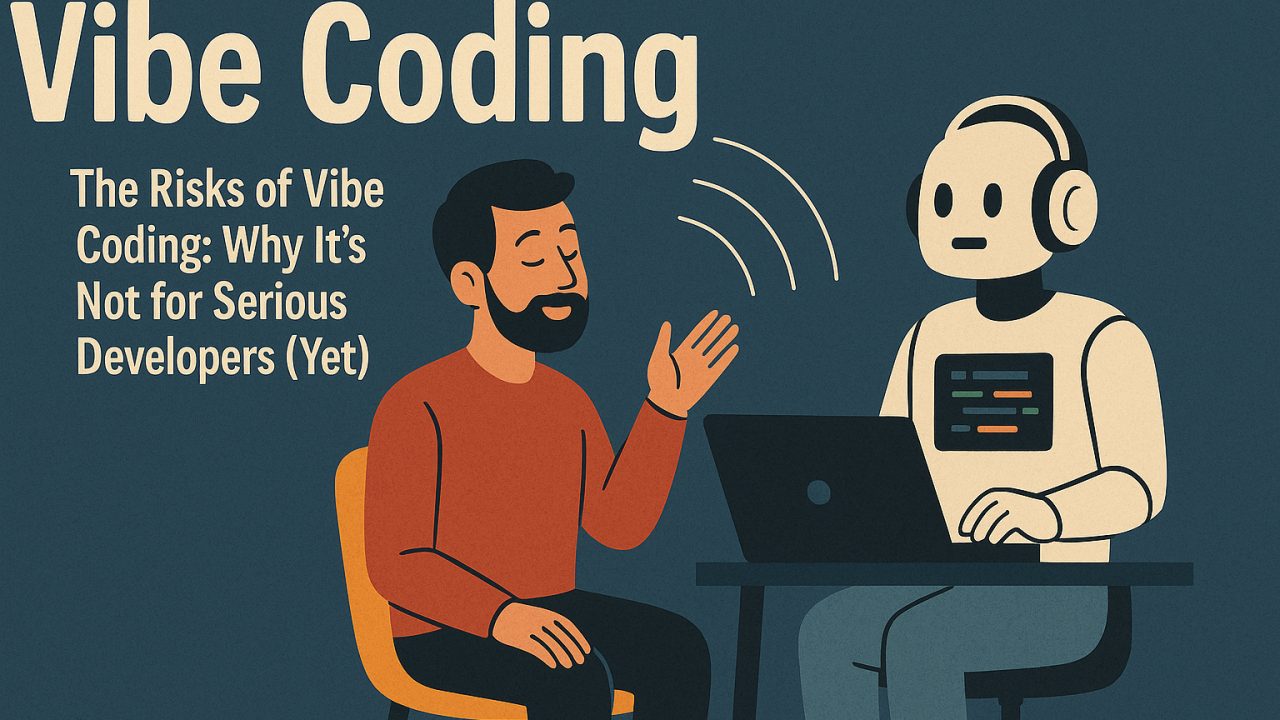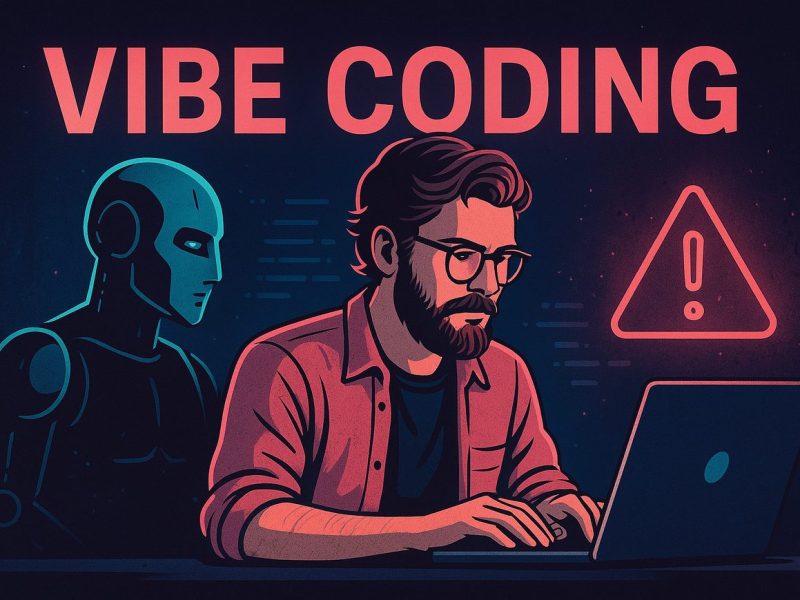How Vibe Coding is Democratizing Development and Unleashing Creativity
“We’re entering an era where the best programmer isn’t the one who writes the most code, but the one who best articulates problems.” — Andrej Karpathy, Co-founder of OpenAI
The Paradigm Shift: From Syntax to Intent
Vibe coding represents the most significant transformation in software development since the advent of high-level languages.
Coined by AI pioneer Andrej Karpathy in early 2025, this approach redefines programming as a conversational collaboration between human intention and AI execution. Instead of manually crafting each line of code, developers describe desired outcomes in natural language, while AI systems like GitHub Copilot, Claude, and Cursor generate functional implementations.
Y Combinator’s latest data reveals that 25% of their Winter 2025 startups have codebases that are 95% AI-generated, while Google reports that approximately 25% of its new code is AI-assisted. This isn’t merely incremental improvement—it’s a fundamental restructuring of the development lifecycle.
1. Democratization: When “Everyone” Becomes a Developer
The Death of Technical Gatekeeping
Vibe coding demolishes traditional barriers to software creation. Tools like Lovable.dev and Bolt.new enable domain experts to build functional applications through natural language prompts alone. For example:
Journalists creating custom data scrapers without Python knowledge
Biologists building protein-folding visualizations
Teachers prototyping educational games during lunch breaks.
“With vibe coding, if you have an idea, you’re only a few prompts away from a product.” — Y Combinator Startup Founder
The “Software for One” Revolution
Kevin Roose’s concept of hyper-personalized applications thrives in this environment. Marketing analysts now build campaign dashboards tailored to their specific KPIs. Finance directors create custom forecasting tools that integrate with proprietary systems. Even children build Minecraft mods through voice commands.
Replit reports that 75% of their users never write a single line of code, relying entirely on AI-generated implementations.
UX Implications: Designing for Citizen Developers
This democratization demands new design paradigms:
Prompt engineering interfaces with auto-suggested phrasing (e.g., Lovable.dev’s prompt templates)
Visual feedback loops showing real-time code generation (e.g., Bolt.new’s live previews)
Guardrail systems preventing critical errors in AI output
2. 10x Speed: Prototyping in Hours, Not Weeks
Case Study: From Concept to MVP in 90 Minutes
A fintech team recently used v0 by Vercel to prototype a banking dashboard:
Prompt: “Responsive dashboard with fraud detection alerts, transaction grid, and spending charts” → Generated React/Tailwind UI in 12 seconds
Prompt: “Connect to Plaid API for transaction data” → Implemented OAuth flow
Prompt: “Add anomaly detection for transactions over $5,000” → Created Python backend service.
Traditional timeline: 3 weeks → Vibe coding timeline: 87 minutes.
The Iteration Velocity Multiplier
Error correction: Paste error messages into tools like Cursor → Instant fixes
Refactoring: “Convert this to React hooks” transforms legacy code
Cross-platform adaptation: “Make this iOS-compatible” regenerates SwiftUI.
IBM engineers used this approach to prototype a financial planning app in hours—a project previously estimated at six weeks.
3. Cognitive Liberation: From Boilerplate to Breakthroughs
The Great Focus Shift
Vibe coding redistributes developer effort:
| Traditional Coding | Vibe Coding |
|---|---|
| 70% implementation | 25% implementation |
| 20% debugging | 15% debugging |
| 10% architecture/UX | 60% architecture/UX refinement |
Source: GitHub Engineering Survey 2025
Developers now spend cognitive capital on:
Complexity management: Designing fault-tolerant distributed systems
UX refinement: Microinteractions, accessibility, emotional resonance
Ethical considerations: Bias detection, privacy architectures
The Emergence of Hybrid Roles
Y Combinator notes the rise of “Product Engineers”—developers who absorb product management responsibilities as AI handles implementation. This manifests as:
Conducting user interviews during “AI sprint cycles”
Prototyping 3 UX variants simultaneously
Implementing real-time analytics instrumentation
4. Accelerated Learning: Conversational Mastery
Framework Exploration Without Tears
Frontend developers now onboard to new frameworks through AI dialogues:
User: "Show me SvelteKit equivalent of Next.js getServerSideProps" AI: Here's SvelteKit's load() function with caching examples...
Result: 68% faster framework adoption compared to documentation study
The Apprenticeship Model
Tools like Cursor function as always-available mentors:
“Explain this Kubernetes operator pattern” → Layered explanations
“Optimize this SQL query” → Execution plan visualization
“Secure this API endpoint” → OWASP-compliant solutions
Anthropic’s Claude 3.5 Sonnet demonstrates particular aptitude for contextual learning, with users reporting it wrote “a bitmap import function in 30 seconds that would’ve taken me hours”.
Essential Vibe Coding Tools (2025 Ecosystem)
For Non-Technical Creators:
| Tool | Strengths | Ideal Use Case |
|---|---|---|
| Lovable.dev | Marketing-optimized templates | Landing pages, content sites |
| Bolt.new | Browser-based full-stack building | Quick MVPs, hackathons |
| v0 (Vercel) | Production-grade React generation | Web app frontends |
For Professional Developers:
| Tool | Superpower | Framework Support |
|---|---|---|
| Cursor | AI-native refactoring | React, Python, Go |
| GitHub Copilot | Context-aware completions | 80+ languages |
| Cody | Enterprise codebase mastery | Java, C#, legacy systems |
Source: DEV Community 2025 Tooling Survey
Strategic Implementation of Vibe Coding: Avoiding the Pitfalls
While transformative, vibe coding introduces new challenges requiring mitigation:
Technical Debt Amplification
A Stanford study found 40% of AI-generated code contains security vulnerabilities when unchecked. Mitigation strategies:
Tiered implementation: Use AI for prototypes but human review for core systems
Automated scanning: Integrate Snyk, Semgrep into AI workflows
Architecture governance: Maintain decision logs for AI-generated components
The Expertise Paradox
Teams report 17% performance drops when novices use vibe coding without supervision. Solution:
Pair “Vibe Specialists” (prompt engineers) with domain experts
Maintain “knowledge.md” files (as in Mocha) to guide AI context
Implement prompt review sessions
“Vibe coding without oversight is like giving a chainsaw to a toddler—spectacular but dangerous.” — Principal Engineer, Fintech Startup
The Future Human Developer: Curators of Complexity
As we approach 2026, the role evolves beyond coding:
Prompt architects crafting precise intention blueprints
Ethical auditors ensuring AI outputs align with regulations
Experience strategists focusing on emotional UX resonance
Tools like Trickle AI now integrate user testing feedback directly into prompt cycles, creating closed-loop refinement systems where user emotions directly shape code generation.
Conclusion: The Augmented Creator
Vibe coding doesn’t eliminate developers—it elevates them. By offloading syntactic implementation to AI, professionals gain capacity for:
Cross-disciplinary innovation (e.g., bioinformatics + UI design)
Human-centered problem solving (elderly accessibility interfaces)
Systems thinking (climate modeling visualizations)
The most successful teams will be those who master intentional delegation—knowing precisely when to direct AI and when to intervene manually. As Karpathy observed, it’s about developing “taste” in software curation rather than manual construction.
“We’re not automating developers out of existence—we’re amplifying them into superheroes.” — CEO, Replit
Explore the tools mentioned:


